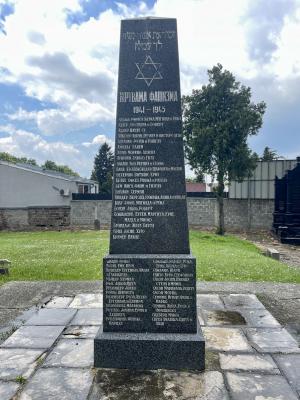Obj. ID: 44049
Jewish Funerary Art Holocaust Memorial in the Jewish Cemetery in Zemun, Serbia, 1948
To the main object: Jewish Cemetery in Zemun, Serbia

Memorial Name
No official name
Who is Comemmorated?
Jewish Victims of the Holocaust from Zemun
Description
The monument has the shape of an obelisk made of black marble standing on a flat platform. The front side features the Magen David and Serbo-Croatian (in Cyrillic script) and Hebrew inscriptions on the top, underneath are the names of the victims. Other sides of the memorial bear only the names of the victims, 574 in total.
Inscriptions
Hebrew
זכור את אשר עשה לך עמלק
Translation: Remember what Amalek did to you (Deut. 25:17)
Serbo-Croatian
Жртвама фашизма 1941-1945
Translation: To the victims of fascism 1941-1945
[All four sides of the monument bear the names of victims, 574 in total]
Commissioned by
The Jewish Community of Zemun
sub-set tree:
It is assumed that Jews started settling in Zemun in the Middle Ages. However, according to the existing archival material, we can confidently say that Jews resided in this city in 1726. The cemetery was founded in 1747. Between 1770 and 1780, Hevra Kadisha was established. There were two synagogues. The Ashkenazi synagogue on 5 Rabin Alkalaj Street was inaugurated in 1863 and the Sephardi Synagogue in 1871 at 3 Dubrovačka Street.
At the beginning of the 20th century, the Jewish population numbered around 1000. Most Zemun Jews perished in the concentration camps of Jasenovac and Stara Gradiška. The number of Holocaust survivors is 115. The Sephardi synagogue was demolished in 1947, there is no memorial plaque. An Ashkenazi synagogue exists today. The building is used as a restaurant and there is no memorial plaque. The Jewish Community of Zemun is active today.
The monument to the victims of fascism was unveiled in the Jewish Cemetery in 1948. Zemun-born Dr. Alber Vajs, the first afterwar president of the Federation of Jewish Communities of Yugoslavia, initiated the erection of the monument along with the members of the Jewish Community Zemun.
Between 1947 and 1948, there were several similar "ad hoc, uncoordinated initiatives that were driven largely by the sense of obligation of the surviving Jews towards their murdered relatives and friends" [Kerenji, p. 209]. As a result of these initiatives small monuments and plaques were dedicated by communities in Vojvodina, among them Subotica, Sombor, Stara Kanjiža and Senta.
Commemoration ceremonies by this monument have been annually held by the Jewish Community of Zemun on July 27, the day the Jews were deported from Zemun in 1942.
The memorial was vandalized in 2001 (?).
Kerenji, Emil, “Jewish Citizens of Socialist Yugoslavia: Politics of Jewish Identity in a Socialist State, 1944–1974,” Ph.D. diss., University of Michigan, 2008, p. 209., https://deepblue.lib.umich.edu/bitstream/handle/2027.42/60848/ekerenji_1.pdf?sequence=1. June 2020 (accessed February 23, 2022)
"Memorials in Zemun," Locations (Vojvodina Holocaust Memorials Project), https://www.vhmproject.org/en-US/Locations/Memorials/26 (accessed July 2, 2023)
Ungar, Olga, "Remembering the Victims: Vojvodina Holocaust Memorials," in Jewish Literatures and Cultures in Southeastern Europe: Experiences, Positions, Memories (=Schriften des Centrums für jüdische Studien, vol. 37) eds Renate Hansen-Kokoruš and Olaf Terpitz, pp. 217-236.
“Život posle smrti: Jevrejsko groblje Zemun,” Jevrejsko groblje Zemun, http://joz.rs/grobljeweb/index.html (accessed July 2, 2023)














